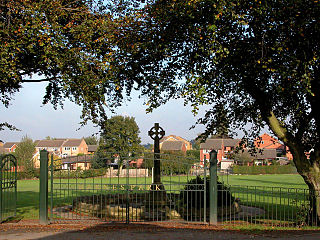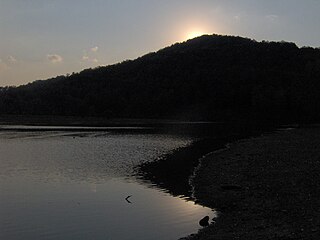
Emery County is a county in east-central Utah, United States. As of the 2020 United States Census, the population was 9,825. Its county seat is Castle Dale, and the largest city is Huntington.

Coal mining is the process of extracting coal from the ground or from a mine. Coal is valued for its energy content and since the 1880s has been widely used to generate electricity. Steel and cement industries use coal as a fuel for extraction of iron from iron ore and for cement production. In the United Kingdom and South Africa, a coal mine and its structures are a colliery, a coal mine is called a "pit", and above-ground mining structures referred to as a "pit head". In Australia, "colliery" generally refers to an underground coal mine.

The Big Sandy River, called Sandy Creek as early as 1756, is a tributary of the Ohio River, approximately 29 miles (47 km) long, in western West Virginia and northeastern Kentucky in the United States. The river forms part of the boundary between the two states along its entire course. Via the Ohio River, it is part of the Mississippi River watershed.

In mining, tailings or tails are the materials left over after the process of separating the valuable fraction from the uneconomic fraction (gangue) of an ore. Tailings are different from overburden, which is the waste rock or other material that overlies an ore or mineral body and is displaced during mining without being processed.

Acid mine drainage, acid and metalliferous drainage (AMD), or acid rock drainage (ARD) is the outflow of acidic water from metal mines and coal mines.
A mining accident is an accident that occurs during the process of mining minerals or metals. Thousands of miners die from mining accidents each year, especially from underground coal mining, although accidents also occur in hard rock mining. Coal mining is considered much more hazardous than hard rock mining due to flat-lying rock strata, generally incompetent rock, the presence of methane gas, and coal dust. Most of the deaths these days occur in developing countries, and rural parts of developed countries where safety measures are not practiced as fully. A mining disaster is an incident where there are five or more fatalities.

The Sydney Tar Ponds were a hazardous waste site on Cape Breton Island in Nova Scotia, Canada.

Surface mining, including strip mining, open-pit mining and mountaintop removal mining, is a broad category of mining in which soil and rock overlying the mineral deposit are removed, in contrast to underground mining, in which the overlying rock is left in place, and the mineral is removed through shafts or tunnels.
Cumberland is an unincorporated community in King County, Washington. Originally a mining camp, Cumberland was named by F.X. Schriner in 1893 after the Cumberland coal region of the Appalachian Mountains. Cumberland gained a post office on October 13, 1894. The Enumclaw post office now serves this area. Although many other mining camps in the area have disappeared, Cumberland can still be found in the Cascade foothills between Nolte State Park and Kanaskat-Palmer State Park. It is accessible via Southeast King County backroads. Several smaller mines dotted the area, including the "Navy" mine, and the Hyde mine, located at the outskirts of town.

Grassmoor is a village in Derbyshire, England, approximately three miles to the south of Chesterfield its distance from London is 148.5 miles. Its original name, according to 16th-century parish records, was Gresmore. The appropriate civil parish is called Grassmoor, Hasland and Winsick. The population of this civil parish at the 2011 Census was 3,360. Grassmoor formerly housed many miners, however all of the local mines in the area have been closed since the mid-eighties.

The Martin County coal slurry spill was a mining accident that occurred after midnight on October 11, 2000, when the bottom of a coal slurry impoundment owned by Massey Energy in Martin County, Kentucky, broke into an abandoned underground mine below. The slurry came out of the mine openings, sending an estimated 306 million US gallons of slurry down two tributaries of the Tug Fork River. By morning, Wolf Creek was oozing with the black waste; on Coldwater Fork, a 10-foot-wide (3.0 m) stream became a 100-yard (91 m) expanse of thick slurry.

Indian Mountain State Park is a state park in Campbell County, Tennessee, in the southeastern United States. Established in 1971, the park consists of 213 acres (0.86 km2) situated at the base of Indian Mountain, a 1,949-foot (594 m) summit that overlooks the Elk Valley in the Cumberland Mountains. The park is located immediately west of the city of Jellico, and the history and development of the two are intertwined to a great extent.

McDade Park is a community park located in Scranton in Lackawanna County, in northeastern Pennsylvania. It is named after former U.S. Representative Joseph M. McDade. The park is located on 200 acres (0.81 km2) of land, containing an outdoor pool, a fishing pond as well as a more isolated pond, basketball courts, hiking trails, tennis courts and two picnic pavilions. The park also contains an arboretum and numerous natural gardens. In addition, the park has a children's playground area, a creek, two baseball fields and numerous hills which are ideal for sledding during northeastern Pennsylvania's winter season. The park has free admission for all activities.
Coal slurry is a mixture of solids and liquids produced by a coal preparation plant.

The Kingston Fossil Plant coal fly ash slurry spill was an environmental and industrial disaster that occurred on December 22, 2008, when a dike ruptured at a coal ash pond at the Tennessee Valley Authority's Kingston Fossil Plant in Roane County, Tennessee, releasing 1.1 billion US gallons of coal fly ash slurry. The coal-fired power plant, located across the Clinch River from the city of Kingston, used a series of ponds to store and dewater the fly ash, a byproduct of coal combustion. The spill released a slurry of fly ash and water which traveled across the Emory River and its Swan Pond embayment onto the opposite shore, covering up to 300 acres (1.2 km2) of the surrounding land. The spill damaged multiple homes and flowed into nearby waterways including the Emory River and Clinch River, both tributaries of the Tennessee River. It was the largest industrial spill in United States history.

The National Mine Map Repository (NMMR) is part of the United States Department of the Interior (DOI), Office of Surface Mining Reclamation and Enforcement. The NMMR resides in the Pittsburgh suburb of Green Tree, Pennsylvania, and collects and maintains mine map information and images for the entire country, including data and maps of coal mines in the anthracite coal region of northeastern Pennsylvania. The Green Tree facility provides and stores, digitally and in microfilm, over 182,000 maps of abandoned mines. This repository contains maps of mine workings from the 1790s to the present day. It serves as a point of reference for mine maps and other information for both surface and underground mines throughout the United States. It also serves as a location to retrieve mine maps in an emergency. The NMMR provides services ranging from retrieving mine related data for economic analysis to assessing the potential risk associated with underground mining. Through analysis of mine maps and related information, the repository assists private and public sectors in industrial and commercial development, highway construction, and the preservation of public health, safety, and welfare. In addition, they collect, reproduce, and maintain a national inventory of mine maps and supporting documentation for private and public interests.

The Knockshinnoch disaster was a mining accident that occurred in September 1950 in the village of New Cumnock, Ayrshire, Scotland. A glaciated lake filled with liquid peat and moss flooded pit workings, trapping more than a hundred miners underground. For several days rescue teams worked non-stop to reach the trapped men. Most were eventually rescued three days later, but 13 died. The disaster was an international media event.

The Fayette State Correctional Institution is a 2,000 bed maximum-security prison located in a remote section of Fayette County, Pennsylvania, in the United States. The prison is located southeast of Pittsburgh and was built to replace two institutions to make the Commonwealth's prison system more energy-efficient. It is the only prison in the Commonwealth where Pennsylvania license plates are manufactured, holding that distinction since 2003.
This is a list of notable events relating to the environment in 2000. They relate to environmental law, conservation, environmentalism and environmental issues.
The Martin County water crisis is an on-going public health crisis that began in 2000, when a coal slurry spill contaminated the area’s water supply with cancer-causing disinfection byproducts and coliform bacteria. Residents report the water having a strong smell of chlorine, discoloration, odd taste, sediment and irritation/burning when in contact with skin. The contamination was caused by the spillage of approximately 300 million gallons of arsenic and mercury concentrated coal sludge into an abandoned underground mine and two tributaries of the Tug Fork River by local coal company Massey Energy Company on October 11, 2000. According to the Environmental Protection Agency (EPA), the spill was one of the worst environmental disasters ever in the southern United States.















